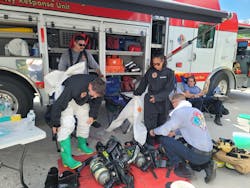Years ago, a prediction was made by a chief officer in New York City, Joseph Galvin, when he wrote a letter to The New York Times to share insight into the future of the fire service. This experienced deputy chief warned those people who were about to enter the fire service to brace themselves for massive changes. He hinted at recruitment and retention issues: Unless funding to provide a full spectrum of services could be identified, crews would be exposed to increased dangers. Galvin expressed concerns that the fire service was without a “basic” system of strict policies, regular training, and supportive post-incident reviews for public education, code enforcement, company inspections and pre-incident planning efforts.
Of course, the fire service evolved over the years since Galvin’s letter was published, but it never drifted from the core mission of community protection. Recently, the concept of an all-hazards emergency response model emerged out of the original duty of structural firefighting and, eventually, embracing emergency medical care. Thus, the goal of a modern fire company now is handling a wide range of natural and human-made threats.
Today, a common thread in “answering the alarm” is assessing conditions that are filled with numerous harmful hazardous chemicals while maintaining a proper level of safety. Career, combination and volunteer departments work in an era of unparalleled production, use, storage and transportation of hazardous materials. Departments, despite tight training budgets, must have a transition plan for new operational challenges regardless of the shortage of staffing, equipment and supplies. Managing and mitigating hazmat incidents requires leadership, partnerships and research.Responder ‘silent killers’
There are chiefs, officers and firefighters who claim that the fire service is under siege and that it needs a better improvement path.
After teaching at the National Fire Academy (NFA), I witnessed many significant changes in the Command and Coordination curriculum, from adherence to the incident command system requirements to certification for special operation positions.
Decades ago, health, fitness and stress weren’t front-burner topics, yet in 2023, first responders no longer merely can just “do the job.” They must be better prepared physically and emotionally to make difficult decisions at all levels.
As a fire service instructor, it seems to me that the most challenging “no-notice” incident is a fire that has a sudden discharge of hazardous products that results in a rapid release of heat (for example, a blaze at a warehouse where lithium-ion batteries are stored or a motor vehicle accident that involves an alternative-fuel automobile).
I experienced a street vendor who was storing more than two dozen propane cylinders in a nonsprinklered garage. One cylinder was dropped, and the heavier-than-air vapors collected near the floor and found an ignition source at a heating unit. The incident focused on expansion ratio of the propane, containment of the blaze, protection of surrounding exposures, evacuation of nearby neighbors and the potential of a boiling liquid expanding vapor explosion (BLEVE).
Many other hazmat incidents, such as elevated carbon monoxide levels, can be viewed as the “silent killers” to the emergency services. Often, first responders get too close to a gaseous release or a liquid spill, and they might unknowingly enter a vapor cloud before meters are used to identify the product that escaped its containment. A poor size-up could result in response personnel finding themselves trying to catch up to make strategic and tactical corrections to initial operational decisions. Without an organized approach of specific sequence steps, dangerous tasks might be attempted.Numerous puzzle pieces
Although emergency responders and educators understand the value of pre-incident planning and the worth of working with knowledgeable partners, many departments find it a difficult endeavor to allocate adequate time to develop an effective interagency response plan that keys on dealing with “out of control” hazmat incidents.
Responding to transportation accidents and discovering leaking drums in a factory can be frequent occurrences for a department. Using encapsulated gear to make entry or to carry out the process of transfering solids to overpack containers can become a complicated procedure that involves explicit technical steps.
The real world of management and mitigation of a hazmat threat involves much more than simply reading placards and classifying container shapes. It goes beyond obtaining shipping papers and hoping that a Clean Cab program will prevent firefighters from developing cancer. Skilled prevention awareness addresses containment, confinement and isolation to minimize negative consequences of a release.
Often, checking resource books for chemical and physical properties along with health hazards is helpful, but this information is only a piece of the puzzle. Observations and cautious judgment are critical. Logical problem-solving techniques are essential. What’s needed at the emergency scene is the ability to apply the printed facts and figures and the visual information in an organized manner.
Although I found the DECIDE approach (detect, estimate likely harm without intervention, choose objective, identify actions, do the best option and evaluate progress) helpful when I made command and safety decisions, it was clear to me that I needed specific operational reminders for initial rules of engagement. A tailor-made template could be extremely helpful to a company officer for making a “mental shift” to a cautious hazmat responder from an aggressive structural firefighter.Include basics, anticipate unknowns
The priorities of an incident commander (IC)—life safety, incident stabilization and property conservation, as taught at the NFA—never change. They are without doubt the basis for strategic analysis and tactical evaluations.
A complex incident that starts to spread out and that might require several operational periods for its resolution requires a baseline foundation that’s built on best scene-control practices but also needs a checklist or a job aid.
Today, many departments have workable standard operating guidelines that are rooted in the National Incident Management System (NIMS) as directed by Homeland Security Presidential Directive 5. However, the National Response Framework is very general in scope for operational coordination and timely warnings to the public. Work assignments at hazmat incidents must be clear for setting up safe operating zones and reducing ignition sources.
For myself, as a former hazmat task force unit leader in Philadelphia, I needed to develop an approach that was easy to remember but inclusive of tactical actions and safety guidelines for first-alarm units and a hazmat response team. I call the approach the “SHOULDIS Technique.”
‘S’ Stage initial units and set up a stationary incident command post for overall command and control oversight.
Self-deployment and independent deployment can be risky. Strict accountability—a tag-in/tag-out procedure—is essential, and no personnel should enter into a spill or vapor cloud, regardless of the scenario, until the product is identified—which can take a few moments, when waybills of landing or cargo manifests are available, or take hours, when samples of a product must be obtained.
Safety officers must be designated to identify and correct health and safety concerns.
Standby safety team (backup group) members who are wearing the same level of protective gear as entry team members increase the probability that sufficient personnel are available to complete all tasks.
Shelters must be considered in a contingency evacuation plan to account for the possibility of damaged containers or vessels.
‘H’ A Hot Zone must be established early. High-hazard zones need clearly marked perimeters, using detection equipment, with single-access points that restrict entry to responders who have appropriate baseline medical clearance, PPE and proper training.
Halt when there are drastic changes in the noise level at the relief valve or when plants, vegetation and animals in the immediate area show signs of toxicity.
‘O’ Oxidizers and explosives require special precautions.
Outward position apparatus, because it’s much easier to drive an emergency vehicle forward than it is to drive it backward.
‘U’ Upwind, uphill and upstream are ideal positions for the key facilities, such as the incident command post, the staging area, rehab areas and field observation points.
Whenever possible, utilize structures that have built-in fire protection features and alarm systems, HVAC, containment pits, holding tanks, dikes, atmospheric monitoring equipment and security cameras.
‘L’ Lines of water and unmanned master streams should be placed at or near a flammable range in an umbrella fashion to control nonwater-reactive vapors.
A logistics section chief and a liaison officer are positions that must be filled, so the IC isn’t overwhelmed.
‘D’ Decon must be prompt.
Delay the entrance of an entry team into a contaminated area until its members are suitably briefed and have been medically evaluated.
Delegate tasks and keep a reasonable span of control on the incident that’s based on the nature of the work that’s required, the experience of the members of the crews, and the hazards and safety factors that are in play—in addition to respecting a ratio of, at minimum, 3-to-1 and, at maximum, 7-to-1 personnel to supervisor.
Documentation is an ongoing process, and all department members must be aware of the signs and the symptoms of exposure before demobilization.
Darkness and insufficient supplies (disposable clothing, plastic bags, soap, neutralizing solutions) lead to a defensive position.
‘I’ Ignition sources must be eliminated, and products that escaped must be identified.
Investigate chemical characteristics from at least three separate reference sources. Industry leaders and national organizations can provide accurate information; however, remember, when three or more chemicals are released and mix, there are no experts.
Isolate the immediate area and monitor it with the appropriate instruments for the circumstance, such as multigas detectors, explosive meters and oxygen indicators.
‘S’ The science group that exists within the hazmat branch can assist the IC with research into toxicity, containment, evacuation and potential explosions.
Stopping or slowing the flow of materials always is a top consideration.
Salvage procedures shouldn’t present any additional safety risk to first responders, wildlife or the environment. Shippers, manufacturers and private contractors often are better equipped than are first responders for permanent disposal duties. Any sudden hazmat incident surely will result in financial, legal and operational costs. A predetermined systematic approach saves time in making critical decisions.
Act now
Having a checklist improves your readiness for a local or a large-scale hazmat response. Now is the time for you to create and determine work assignments for an initial, expanded and/or extended operation.
We never can forget the lessons from the past. Now is the time to increase the likelihood of a proper level of service and personnel safety by being better prepared.
About the Author

William Shouldis
William Shouldis retired from the Philadelphia Fire Department as a deputy chief after serving in both line and staff positions for more than 34 years. His assignments included working directly for the fire chief on labor relations and accountability issues, field commander for half of the city, the department’s safety officer, director of training and the leader of the Hazardous Materials Task Force. Shouldis is an instructor at the National Fire Academy and the Emergency Management Institute. He earned a master’s degree in public safety from St. Joseph’s University.



